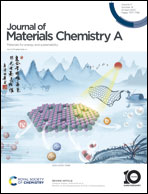Two-dimensional layered Dion–Jacobson phase organic–inorganic tin iodide perovskite field-effect transistors†
Abstract
Two-dimensional (2D) layered Dion–Jacobson (D–J) phase organic–inorganic Sn-based perovskites show potential applications in field-effect transistors, similar to their Ruddlesden–Popper (R–P) counterparts; however, they have not attracted sufficient attention. In this work, we report on the investigations of 1,4-butanediamine tin iodide perovskite (BDASnI4) and the demonstration of polymer-bottom-gated BDASnI4 thin film field-effect transistors. First-principles calculations reveal that BDASnI4 possesses a 2D layered D–J structure with small lattice distortions, which facilitates in-plane charge transport in the [SnI6]4− frameworks. Theoretical results and physical characteristics prove that the single BDA2+ layer eliminates the van der Waals gap in R–P perovskites, resulting in enhanced structural stability and a reduced quantum well effect. More importantly, the strong interlayer electronic coupling through the shortened apical I–I interactions improves the out-of-plane charge transport in BDASnI4, which is regarded as a limitation for 2D R–P perovskites. BDASnI4 transistors exhibit p-type high-performance with enhanced operating stability under ambient conditions. The hole mobility achieved in the champion device is 0.58 cm2 V−1 s−1, approaching that of amorphous silicon. Our work provides theoretical and experimental bases for developing 2D layered D–J phase perovskites for field-effect transistors.



 Please wait while we load your content...
Please wait while we load your content...